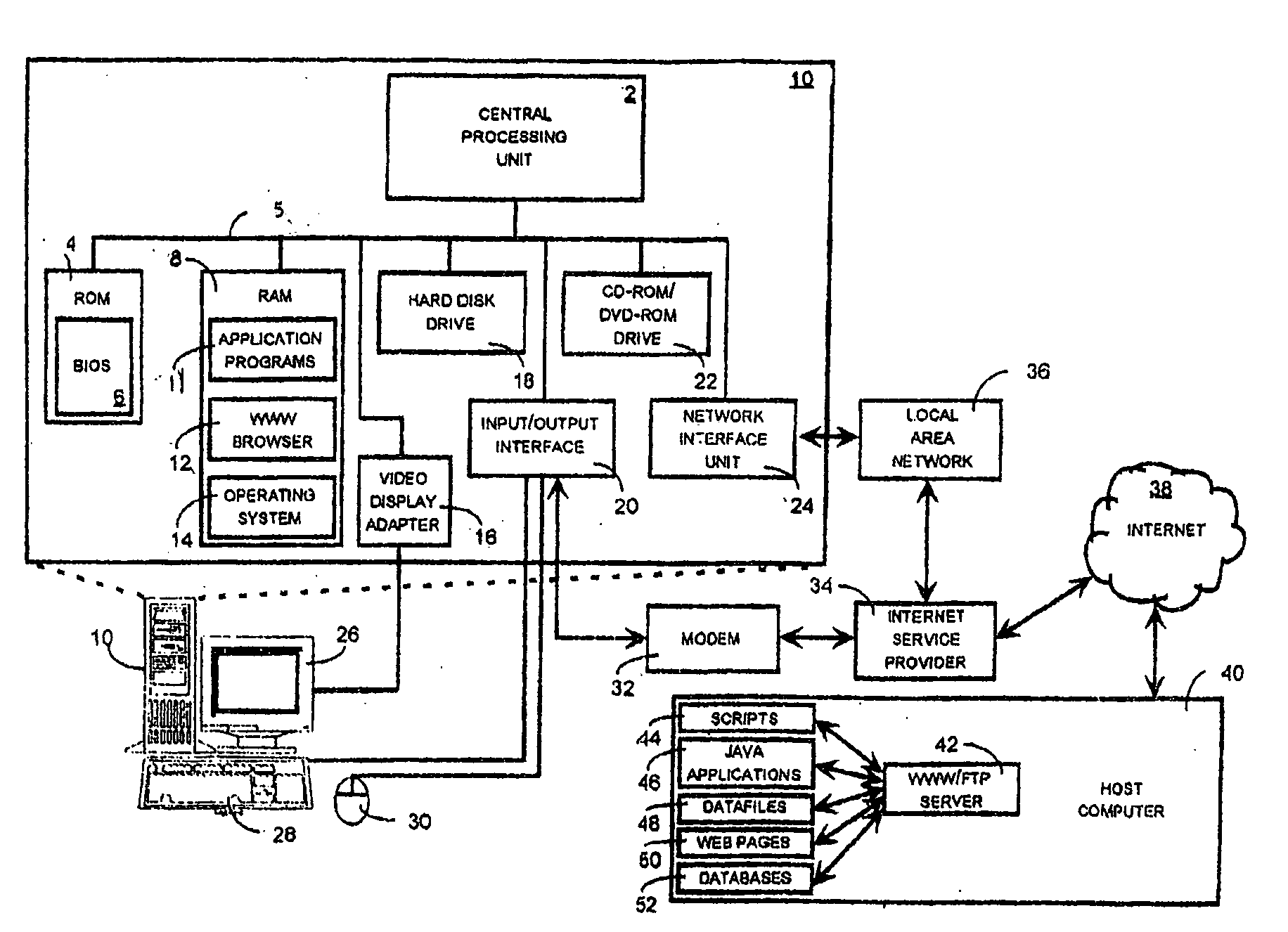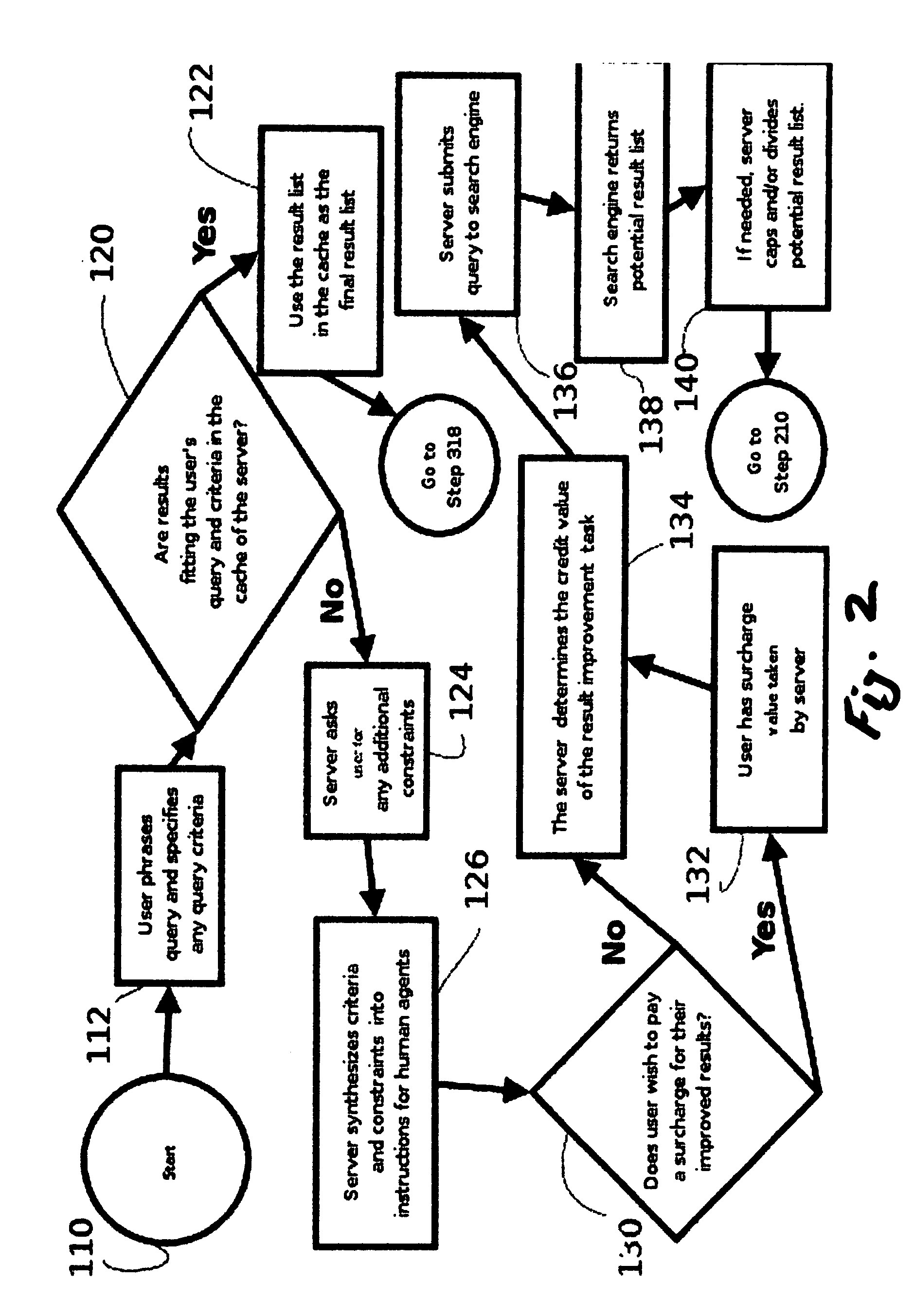[0010]One
advantage of the invention is that it the reduces users' effort because while retaining the flexible and subtle power of
human judgment they do not have to spend their own time determining whether or not the results of their query match their requirements. Current state-of-the-art technology cannot match human judgment in determining whether a given result is appropriate to the needs of the user who initiated the query. For example, because of the large number of resources available in knowledge-bases and corpora of documents like the
World Wide Web, searching by automated techniques does not usually return purely negative results or no result whatsoever, but instead returns some number of results that fit the criteria mixed with a much larger number of results that do not. Unlike U.S. Pat. No. 6,434,549, our process is not aimed at
information exchange that relies on humans agents having either personal access to the knowledge or searching on for knowledge on behalf of the user, but at creating an improved
list of results whether or not the criteria are knowledge-based or not. The criteria may be knowledge-based, such as whether or not a given search result contains the information that the user is seeking, or they may be based on other kinds of criteria such as the physical characteristics of the result, for example whether or not a given result can be displayed to a user on the screen of their
cellular telephone. Our process discards the results that fail to meet the criteria through assessment by a human of the original query and its results, and only results that fit the criteria are displayed to the user for browsing. This “
pruning” of results is an
advantage to the user if they only have time to browse a few results and do not want to be distracted by unusable results. This is in contrast to prior art such as U.S. Pat. No. 5,628,011 that emphasize new automatic algorithms, such as trying to combine results automatically from multiple search engines. We
exploit the fact that humans can often easily determine whether or not a given result can be assessed as fitting the criteria of a query, while computers more often fail at this task regardless of the particular
algorithm employed and / or regardless of how many differing search engines are employed.
[0011]The power of human judgment can out perform automated techniques in many cases, such as detecting unwanted advertisements, web pages which are merely collections of links, material not suitable for children, and other varieties of contextually unhelpful results. These unusable results are often retrieved because of weaknesses in the
automated algorithm the search engine is using or because the query terms are ambiguous or express complex
information needs that are beyond the capacity of automated methods to determine. The invention combines the complementary strengths of, on the one hand, computers, to retrieve many possible results and, on the other hand, of humans, to determine quickly whether or not a web-page fits some particular criteria. This in contrast to search engines that focus on automated processes, as is the case for most current Web search engines, as exemplified by U.S. Pat. No. 5,864,846.
[0012]Another
advantage of the invention is
scalability and speed. Because the judgment task is split into fixed-size pieces and distributed to multiple agents, and each agent is presented with a constrained interface and a fixed size of task,
human assessment is quick and scalable. Earlier efforts such as Humansearch (See Leonard, Andrew: “The Brain Strikes Back,” Salon
Magazine; April 1997) and Google Answers (See Olsen, Stefanie: “Google gives some advice . . . for a price,” CNet News; April 2002) did not scale well because their human experts had to find, synthesize, and otherwise annotate information from possibly a wide variety of sources, including their own knowledge. The single expert was given a nearly
infinite number of possibly difficult choices. Many systems based on human experts require a good deal of expertise in phrasing the answers or creating annotations in
natural language. Instead, since our process restricts the choices made by our human agents, the task of human assessor is simply to discriminate whether each result fits the particular criteria given by the user, or to annotate each result with respect to certain simple properties, instead of paraphrasing or synthesizing information. In contrast to prior art, this efficient method of identifying, annotating and / or
ranking results that fit the needed criteria can be accomplished quickly and often by non-experts.
[0013]The
modularity of the method enables the use of redundancy to provide
quality control. Multiple agents can be given the same subset of the results to assess, their annotations compared and under-performing agents identified.
[0014]Another advantage of the invention is that its results resemble the results given by traditional search engines, but much improved because they include only those results which have been judged by a human to fit the user's criteria. Prior art often involved interfaces far removed from traditional search engine interfaces, such as chatting with an expert as given in U.S. Pat. No. 6,745,178. While our interface does give the user the ability to specify their criteria with much greater precision than ordinary search engines, like automated search engines our process returns an easy-to-use
list of results. Since unwanted results are subtracted from the results of the automated query, the improved
list of results returned by our invention has the advantage of being smaller than the list returned by a
fully automated search engine while still being presented in the format users are accustomed to using.
 Login to View More
Login to View More  Login to View More
Login to View More 


